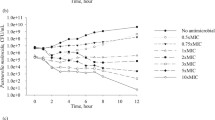Abstract
Background
The minimum inhibitory concentration (MIC) is the in vitro reference value to describe the activity of an antibacterial against micro-organisms. It does not represent the dynamic effect of the antimicrobial at any point in time, but rather the total antimicrobial effect over the incubation period at a fixed concentration.
Objective
To explore the concentration-effect relationship of antimicrobial concentrations against micro-organisms in relation to the MIC.
Methods
Time-kill curves were generated for ceftazidime, meropenem and tobramycin against Pseudomonas aeruginosa. The Hill equation with variable slope was fit to the time-kill data, and mathematical models of growth and kill were explored with reference to the MIC.
Results
With declining concentrations, bacterial killing will decrease until a specific threshold concentration is reached. This concentration, at which bacteria are neither killed nor able to grow, is named the stationary concentration (SC) and is not equal to the MIC. Pharmacokinetic/pharmacodynamic simulations over a range of kill rates, growth rates and slope factors showed that for β-lactam antibacterials, the SC is close to the MIC value, which may explain why concentrations in vivo need to be above the MIC, while regrowth of bacteria occurs when concentrations decline below the MIC. For concentration-dependent antibacterials, such as aminoglycosides and quinolones, the SC is shown to be markedly different from the MIC and, in general, is much lower.
Conclusion
The MIC is not a good pharmacodynamic parameter to characterise the concentration effect relationship of a given antimicrobial. For ‘concentration independent’ antimicrobials the SC is likely to be close to the MIC, but may be much lower for ‘concentration dependent’ antimicrobials, and may explain sub-MIC effects.





Similar content being viewed by others
References
Craig WA. Pharmacokinetic/pharmacodynamic parameters: rationale for antibacterial dosing of mice and men. Clin Infect Dis 1998; 26(1): 1–10
Nolting A, Derendorf H. Pharmacokinetic/pharmacodynamic modelling of antibiotics. In: Derendorf H, Hochhaus G, editors. Handbook of pharmacokinetic/pharmacodynamic correlation. Boca Raton (FL): CRC Press, 1995: 363–88
Bouvier d’Yvoire MJY, Maire PH. Dosage regimens of antibacterials: implications of a pharmacokinetic/pharmacodynamic model. Clin Drug Invest 1996; 11: 229–39
National Committee for Clinical Laboratory Standards. Methods for dilution antimicrobial susceptibility tests for bacteria that grow aerobically: approved standard M7-A5. Wayne (NB): NCCLS, 2000
Andrews JM. Determination of minimum inhibitory concentrations. J Antimicrob Chemother 2001; 48 Suppl. 1: 5–16
Mouton JW, Dudley MN, Cars O, et al. Standardization of pharmacokinetic/pharmacodynamic (PK/PD) terminology for anti-infective drugs. Int J Antimicrob Agents 2002; 19(4): 355–8
Mouton JW, Vinks AA, Punt NC. Pharmacokinetic-pharmacodynamic modeling of activity of ceftazidime during continuous and intermittent infusion. Antimicrob Agents Chemother 1997; 41(4): 733–8
White CA, Toothaker RD, Smith AL, et al. In vitro evaluation of the determinants of bactericidal activity of ampicillin dosing regimens against Escherichia coli. Antimicrob Agents Chemother 1989; 33(7): 1046–51
White CA, Toothaker RD, Smith AL, et al. Correction for bacterial loss in in vitro dilution models. Antimicrob Agents Chemother 1987; 31(11): 1859–60
Zhi JG, Nightingale CH, Quintiliani R. Microbial pharmaco-dynamics of piperacillin in neutropenic mice of systematic infection due to Pseudomonas aeruginosa. J Pharmacokinet Biopharm 1988; 16(4): 355–75
Mattie H, van Dokkum AM, Brus-Weijer L, et al. Antibacterial activity of four cephalosporins in an experimental infection in relation to in vitro effect and pharmacokinetics. J Infect Dis 1990; 162(3): 717–22
Corvaisier S, Maire PH, Bouvier d’Yvoire MY, et al. Comparisons between antimicrobial pharmacodynamic indices and bacterial killing as described by using the Zhi model. Antimicrob Agents Chemother 1998; 42(71): 1731–7
EUCAST. Determination of minimum inhibitory concentrations (MICs) of antibacterial agents by broth dilution: discussion document E.Dis 5.1 [online]. Available from URL: http://www.escmid.org/Seviware/Script/SvFiles.asp?.Ref=359 [Accessed 2004 Oct 8]
Vogelman B, Craig WA. Kinetics of antimicrobial activity. J Pediatr 1986; 108 (5 Pt 2): 835–40
Mouton JW, Vinks AATMM, Punt N, et al. Pharmacokinetic pharmacodynamic modelling of bacterial killing in vivo [abstract]. Interscience Conference on Antimicrobial Agents and Chemotherapy; 1997 Sep 28–Oct 1; Toronto
Knudsen JD, Frimodt-Moller N, Espersen F. Pharmacodynamics of penicillin are unaffected by bacterial growth phases of Streptococcus pneumoniae in the mouse peritonitis model. J Antimicrob Chemother 1998; 41(4): 451–9
Zhi J, Nightingale CH, Quintiliani R. A pharmacodynamic model for the activity of antibiotics against microorganisms under nonsaturable conditions. J Pharm Sci 1986; 75(11): 1063–7
den Hollander JG, Mouton JW, van Goor MP, et al. Alteration of postantibiotic effect during one dosing interval of tobramycin, simulated in an in vitro pharmacokinetic model. Antimicrob Agents Chemother 1996; 40(3): 784–6
Tuomanen E. Phenotypic tolerance: the search for beta-lactam antibiotics that kill nongrowing bacteria. Rev Infect Dis 1986; 8 Suppl. 3: S279–91
Smith H. Questions on the determinants of bacterial growth in vivo [online]. Available from URL: http://www.worldscibooks.com/medsci/p233.html [Accessed 2004 Oct 8]
Acknowledgements
We thank Dr Herman Mattie for critically reading the manuscript. No sources of funding were used to assist in the preparation of this study. The authors have no conflicts of interest that are directly relevant to the content of this study
Author information
Authors and Affiliations
Corresponding author
Rights and permissions
About this article
Cite this article
Mouton, J.W., Vinks, A.A. Pharmacokinetic/Pharmacodynamic Modelling of Antibacterials In Vitro and In Vivo Using Bacterial Growth and Kill Kinetics. Clin Pharmacokinet 44, 201–210 (2005). https://doi.org/10.2165/00003088-200544020-00005
Published:
Issue Date:
DOI: https://doi.org/10.2165/00003088-200544020-00005




